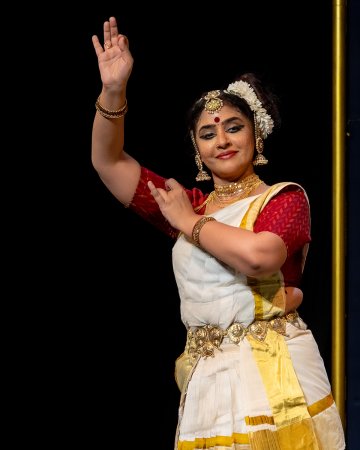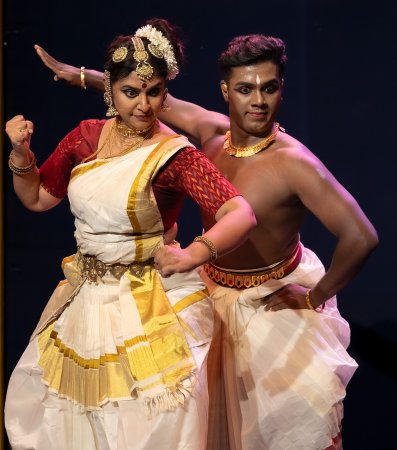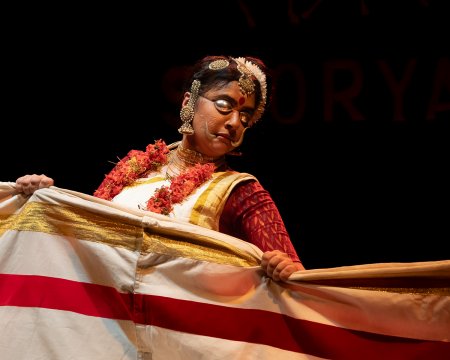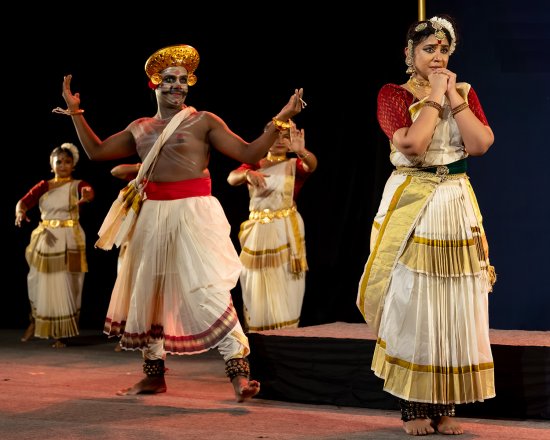
|   |

|   |
Uchchila and others: A Mohiniyattam anthology - Hareesh N. Nampoothiri e-mail: haree@newnmedia.in Photos: Haree Fotografie November 3, 2024 A Mohiniyattam adaptation of six different compositions was presented by Methil Devika and her team of students from Chitrakutam Art House, impressing the packed audience at the Ganesham black box theatre in Thiruvananthapuram. Methil Devika effortlessly adapts to the stage, enriching both the performance and its connection with the audience. Here, too, she masterfully wove diverse themes into the performance, redefining the boundaries of the Mohiniyattam repertoire.  Methil Devika in Peelipattu The team began with a short but elegant Cholkettu, in praise of Siva and Sakthi, which was composed by late Kalpathy Sooryanarayanan and rendered by Kalamandalam Vinod. Methil Devika chose to perform 'Peelipattu' as the next piece, based on the legend of the origin of Krishnanattam at Guruvayur temple. The story comes to life through the characters of Vilwamangalam Swamiyar and the Zamorin, two ardent devotees and the child Krishna. The essence was beautifully captured as the dancer skillfully moved from one role to the other. The composer was Kavalam Sreekumar and had Kottayam Jamaneesh Bhagavathar as the vocalist. Diversity being the core  Bhadrakali Ashtakam The performance featured pieces like Sree Narayana Guru's 'Bhadrakali Ashtakam', set to music by T.M. Krishna, and 'Hridayasutra', embodying the Nirvana philosophy of Gautama Buddha. Both pieces, though rooted in classical traditions, had a unique contemporary feel. Murali Sangeeth and Aparna Sharma performed the vocal parts for these works, respectively. For the former, Devika was joined by Goutham Maheswar and for the latter she had the company of Anghitha Pushpajan, Gayathri Devi, and Sobha Madhu. Ajeissh Menon and Alex Rapheal were the two other members in the team participating in the rest of the group pieces. The dance segments of all the pieces had a touch of elegance, which was executed skillfully by the team of dancers. Between these two pieces, Methil Devika presented another solo titled 'Bhathrumathi', an original composition of her own, with vocals by Meera Rammohan. Its structure echoed the Swathi Thirunal padam "Kaminimani...". Departing from the usual themes in Mohiniyattam -or in any classical dance form, for that matter-it portrayed a dialogue between a heroine and her mother-in-law. Devika was once again fluent in portraying both roles. Tale of Uchchila  Methil Devika in Uchchila 'Uchchila' first premiered two years back during the opening session of the 'Loka Kerala Sabha', hosted by the Government of Kerala. That performance emphasized a grand visual spectacle, designed for a general audience of thousands on the expansive stage of Nishagandhi. Naturally, adaptations were made for this presentation, held on a smaller stage for a few hundred classical dance enthusiasts. The production drew inspiration from the legend of Muchilot Bhagavathi, the tutelary deity of the Vaniyas community. The title character, Uchchila, is a Brahmin girl who possesses in-depth knowledge of the Vedas even in her early teenage years. The senior male scholars were not ready to accept her wisdom and challenged her to a scholarly debate. Little did she know they had other plans when they couldn't defeat her in scholarship. The opening scene set the context and swiftly moved to the crux of the story, with Uchchila's narrative told in a flashback mode. Methil Devika portrayed the female protagonist, while the Brahmin scholar was depicted by Goutham Maheswar. This role resembled that of a Vidooshaka in a Kutiyattam play.  Uchchila Having a genuine Kutiyattam performer delivering the dialogues live, as was done during the premiere, would've made a greater impact. A different approach - one that didn't attempt to imitate the Chakyar attire or mannerisms - might have been more effective here, especially since he continued to dance as well in the same costume. Perhaps the intention was to infuse a Mohiniyattam flavor to Vidooshaka, which could have worked if it hadn't been so closely aligned with the traditional attire. As the story unfolds, scholars devise a plan to tan the character of the teenage girl by asking her about the ultimate pleasure and the worst pain. The girl replies, 'Lovemaking and giving birth,' and they question her chastity. Unwilling to endure this unfair ordeal, she decides to burn herself alive, thus transforming into Muchilot Bhagavathi. The premiere show featured theyyam, live percussion, and additional stage props, all of which were missing from this presentation. It certainly helped capture the audience's full attention on Muchilot Bhagavathi, and the adaptation of 'Thiranottam' from Kathakali/Kutiyattam, gradually unveiling Muchilot Bhagavathi, was particularly intense. The performance was on the concluding day of the 'Dreams Unlimited' choreography festival, a segment of the 47th edition of Soorya Festival organized by Soorya India.  Dr. Hareesh N. Nampoothiri is a visual design consultant by profession, an art lover by obsession and an author, writer, photographer, editor, lyricist, and director by passion. He is also the founder and chief editor of Artograph, a bimonthly e-magazine on arts. |